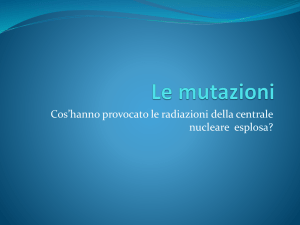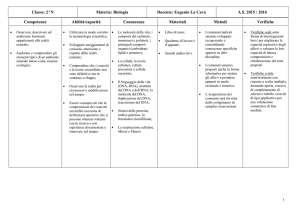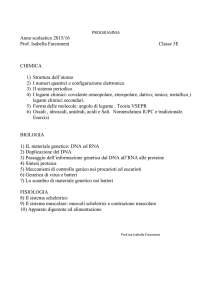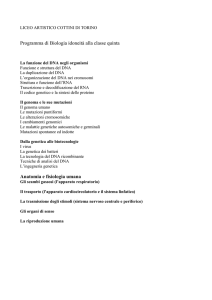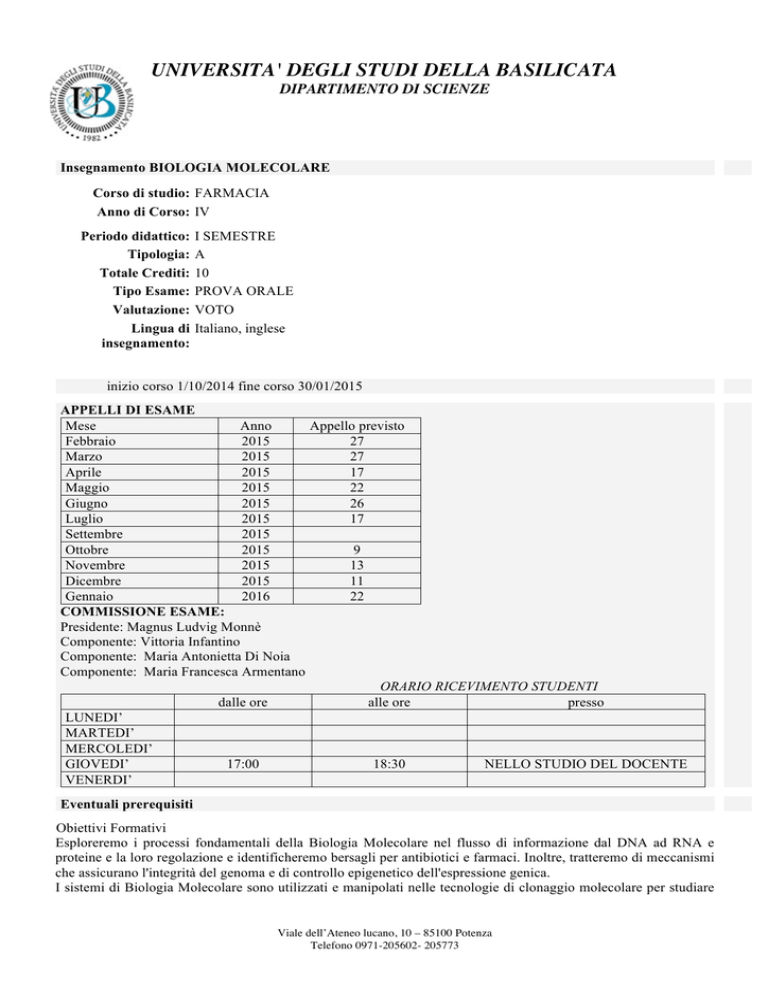
UNIVERSITA' DEGLI STUDI DELLA BASILICATA
DIPARTIMENTO DI SCIENZE
Insegnamento BIOLOGIA MOLECOLARE
Corso di studio: FARMACIA
Anno di Corso: IV
Periodo didattico:
Tipologia:
Totale Crediti:
Tipo Esame:
Valutazione:
Lingua di
insegnamento:
I SEMESTRE
A
10
PROVA ORALE
VOTO
Italiano, inglese
inizio corso 1/10/2014 fine corso 30/01/2015
APPELLI DI ESAME
Mese
Anno
Appello previsto
Febbraio
2015
27
Marzo
2015
27
Aprile
2015
17
Maggio
2015
22
Giugno
2015
26
Luglio
2015
17
Settembre
2015
Ottobre
2015
9
Novembre
2015
13
Dicembre
2015
11
Gennaio
2016
22
COMMISSIONE ESAME:
Presidente: Magnus Ludvig Monnè
Componente: Vittoria Infantino
Componente: Maria Antonietta Di Noia
Componente: Maria Francesca Armentano
ORARIO RICEVIMENTO STUDENTI
dalle ore
alle ore
presso
LUNEDI’
MARTEDI’
MERCOLEDI’
GIOVEDI’
17:00
18:30
NELLO STUDIO DEL DOCENTE
VENERDI’
Eventuali prerequisiti
Obiettivi Formativi
Esploreremo i processi fondamentali della Biologia Molecolare nel flusso di informazione dal DNA ad RNA e
proteine e la loro regolazione e identificheremo bersagli per antibiotici e farmaci. Inoltre, tratteremo di meccanismi
che assicurano l'integrità del genoma e di controllo epigenetico dell'espressione genica.
I sistemi di Biologia Molecolare sono utilizzati e manipolati nelle tecnologie di clonaggio molecolare per studiare
Viale dell’Ateneo lucano, 10 – 85100 Potenza
Telefono 0971-205602- 205773
UNIVERSITA' DEGLI STUDI DELLA BASILICATA
DIPARTIMENTO DI SCIENZE
la funzione dei geni e delle proteine in condizioni normali e patologiche. Infine, descriveremo lo sviluppo delle
nuove strategie terapeutiche e i sistemi diagnostici emersi dalla ricerca di base ed applicata
in Biologia Molecolare.
Programma del Corso
I. Il flusso di informazione.
Il dogma centrale, struttura e funzione del DNA, dell'RNA e delle proteine.
Topologia del DNA e le topoisomerasi. Geni, genomi, nucleosomi e cromosomi.
La replicazione del DNA: le DNA polimerasi, altri enzimi della forca replicativa, regolazione dell'inizio, la telomerasi.
Mutazioni e danni al DNA, sistemi di riparazione.
La ricombinazione omologa e trasposoni.
La trascrizione: le RNA polimerasi, il promotore, i fattori generali della trascrizione.
La maturazione dell'mRNA: capuccio 5', poliadenilazione 3', lo splicing, lo spliceosoma, lo splicing alternativo, l'RNA edit
La traduzione: mRNA, tRNA, amminoacil-tRNA sintetasi, i ribosomi.
La regolazione trascrizionale e traduzionale; sequenze e fattori regolatrici della trascrizione, l'eredità epigenetica, rimodell
I riboswitch, miRNA, siRNA.
II. Metodi.
Clonaggio: PCR, elettroforesi su gel, endonucleasi, DNA ligasi, vettori, trasformazione delle cellule, sequenziamento del DN
Produzione di proteine ricombinanti.
Analizzare macromolecole: tipizzazione del DNA, Southern blot, Northern blot, DNA microarray, geni reporter.
Bioinformatica: banche dati, allineamento ed analisi delle sequenze e delle strutture.
III. I prodotti biotecnologici nell'industria farmaceutica.
Funzione, struttura e produzione delle proteine ricombinanti farmaceutiche, vaccini ricombinanti, anticorpi monoclonali ricom
animali transgenici, terapia genica.
Metodi didattici
lezione frontale/laboratorio
Modalità di verifica dell'apprendimento
esame finale
Testi di Riferimento
•
•
•
James Watson, Tania Baker, Stephen Bell, Alexander Gann, Michael Levine e Richard Losick. Biologia
molecolare del gene. Sesta edizione, Zanichelli.
Maria Luisa Calabrò: Compendio di Biotecnologie Farmaceutiche. EdiSES 2008.
Appunti delle lezioni.
COURSE MOLECULAR BIOLOGY
Course of studies: PHARMACY
UNIVERSITA' DEGLI STUDI DELLA BASILICATA
DIPARTIMENTO DI SCIENZE
Academic Year:
ECTS:
Teaching Methods:
Evaluation
Methods:
Evaluation:
Semester:
Language:
IV
10
Lectures – Lab activities
ORAL EXAM
score on 30 points
I
ITALIAN AND ENGLISH
Course beginning on 1 October 2014 ending on 30 January 2015
Calls for examination
Month
Year
February
2015
March
2015
April
2015
May
2015
June
2015
July
2015
September
2015
October
2015
November
2015
December
2015
January
2016
Examination Panel:
President: Magnus Monné
Member: Vittoria Infantino
Member: Maria Antonietta Di Noia
Member: Maria Francesca Armentano
Expected call
27
27
17
22
26
17
9
13
11
22
Previous requirements:
Learning Outcomes:
In this course, we will explore the fundamental processes of Molecular Biology in
the flow of information from DNA to RNA and protein and their regulation as well as
identify targets for antibiotics and drugs. In addition we will consider the mechanisms
that ensure the integrity of the genome and epigenetic control of gene expression.
These systems of Molecular Biology are used and manipulated in molecular cloning
techniques for the study of proteins and genes in healthy and pathogenic conditions.
Towards the end we describe the development of new therapeutic strategies and
diagnostic systems that have emerged from basic and applied research in Molecular
Biology.
Syllabus:
I. The flow of information.
The central dogma, structure and function of DNA, RNA and proteins.
UNIVERSITA' DEGLI STUDI DELLA BASILICATA
DIPARTIMENTO DI SCIENZE
Topology of DNA and topoisomerases. Genes, genomes, nucleosomes and
chromosomes.
DNA replication: DNA polymerases, other enzymes at the replication fork, regulation
of initiation, telomerase.
Mutations and damage of DNA, systems for repair.
Homologous recombination and transposons.
Transcription: RNA polymerases, promotors, general transcription factors.
Maturation of RNA: 5'-capping, 3'-polyadenylation, splicing, the spliceosome,
alternative splicing, RNA editing.
Translation: mRNA, tRNA, amminoacyl-tRNA synthase, ribosomes.
Transcriptional and translational regulation: regulatory sequences and factors
in trascription, epigenetic inheritance, chromatin remodelling.
Riboswitches, miRNA, siRNA.
II. Methods.
Cloning: PCR, gel electrophoresis, endonucleases, DNA ligase, vectors, transformation
of cells, DNA sequencing.
Production of recombinant proteins.
Analyses of macromolecules: genotyping, Southern Blot, Northern blot,
DNA microarray, gene reporters.
Bioinformatics: data banks, alignment and analysis of sequences and structures.
III. Biotechnologic products in the pharmaceutical industry.
Function, structure and recombinant production of pharmaceutical recombinant
proteins, recombinant vaccines, recombinant monoclonal antibodies, metabolic
engineering, transgenic animals, gene therapy.
Suggested textbooks
• James Watson, Tania Baker, Stephen Bell, Alexander Gann, Michael Levine
• and Richard Losick. Molecular Biology of the Gene. Sixth edition, Zanichelli.
• Maria Luisa Calabrò: Compendio di Biotecnologie Farmaceutiche. EdiSES 2008.
• Notes from the lectures.
Further information:

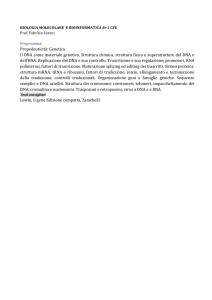
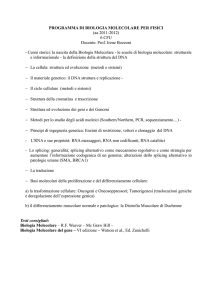
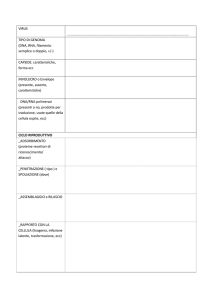
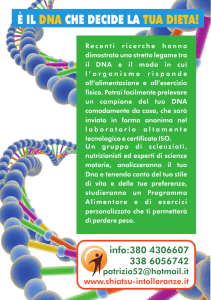
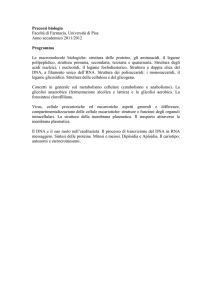
![mutazioni genetiche [al DNA] effetti evolutivi [fetali] effetti tardivi](http://s1.studylibit.com/store/data/004205334_1-d8ada56ee9f5184276979f04a9a248a9-300x300.png)
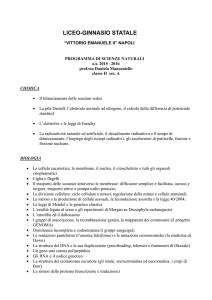
![ESTRAZIONE DNA DI BANANA [modalità compatibilità]](http://s1.studylibit.com/store/data/004790261_1-44f24ac2746d75210371d06017fe0828-300x300.png)
